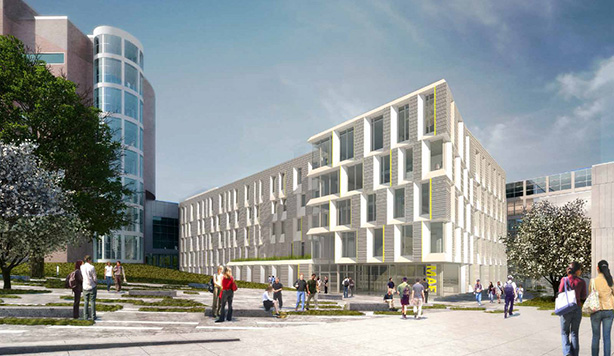COVER STORY SIDEBAR

Rendering of what Upson Hall's exterior will look like after renovations, updates and expansions.
Engineering quad boasts modern look, and a more useful inside
As technology advances, Cornell Engineering is changing – inside and out. New laboratory spaces are being created for such fields as robotics and biomedical engineering, facades of older buildings are being updated, offices and classrooms are being rearranged, and existing classrooms are being upgraded with new teaching technology.
"We're bringing people together for easier collaborations," says Bill Bader, director of facilities for engineering. In 2014, the Computing and Information Science faculty moved out of Upson Hall into their new home in Gates Hall, just across Hoy Road. Some of the freed office space will bring mechanical and aerospace engineering faculty – previously scattered across several buildings – together at last.
The entire fifth floor and parts of the fourth floor of Upson Hall will become a center for robotics, with open lab space where robots can roll around, and offices for researchers in mechanical and aerospace, computer and electrical engineering, and computer science who collaborate on robotics. "We're really spread out, so the idea is to co-locate and realize some of the advantages of proximity," says Ross Knepper, assistant professor of computer science.
Student project team space in the basement of Upson will expand by 50 percent. A widened window in the first-floor atrium will allow visitors to look down on the floor below and observe the diverse collection of equipment and activity.
The changes follow a master plan for the college that has grown with the times. "We did one in 2008," Bader recalls. "Then the recession hit, and we didn't have the resources." The plan was revised in 2011 and another update will be started soon. Inputs to these plans have been sought from faculty, staff and students, in part through an interactive website.
"These current renovations are just the start. The entire Engineering campus eventually will see changes that will bring our facilities and academics to the next century," Bader says.
– Bill Steele